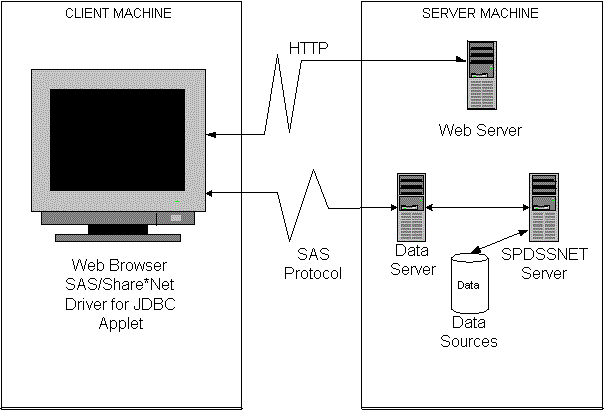Using JDBC to Access SPD Server Tables
Read this section if you do not have Base SAS software
on the network client, but you want to use JDBC to query SPD Server
tables from any client on the network that has a browser. In addition,
you must have SPD Server tables available for use somewhere on the
network and SPD Server and SPD Server SNET server running on the same
server as the Web server to use JDBC to access SPD Server tables.
JDBC Code Examples and Tips
<applet code=CLASSPATH.*.class codebase=../ width=600 height=425> <param name=url value=jdbc:sharenet://spdssnet_node:PORT> <param name=dbms_options value=DBQ='LIBNAME' HOST='host_node' SERV='NNNN'> <param name=spdsuser value=userid> <param name=sharePassword value=thepassword> <param name=shareRelease value=V9> <param name=dbms value=spds> </applet>
Limitations of Using JDBC with SPD Server
Example of a JDBC Query That Gets a List of Tables (Used with SPD Server)
SELECT '' AS qual,
LIBNAME AS owner,
MEMNAME AS name,
MEMTYPE AS type,
MEMNAME AS remarks FROM dictionary.tables AS tbl
WHERE ( memtype = 'DATA' OR memtype = 'VIEW' OR memtype = 'SYSTEM TABLE' OR
memtype = 'ALIAS' OR memtype = 'SYNONYM')
AND (tbl.LIBNAME NE 'MAPS' AND tbl.LIBNAME NE 'SASUSER' AND tbl.LIBNAME NE 'SASHELP')
ORDER BY type, qual, owner, name
Example of a JDBC Query That Gets Metadata about a Specific Table (Your Data File)
SELECT '' AS qual,
LIBNAME AS owner,
MEMNAME AS tname, name,
length AS datatype,
type || ' ',
length AS prec,length,
length AS scale, length AS radix, length AS nullable,label,
FORMAT FROM dictionary.columns AS tbl
WHERE memname = 'your data file'
AND (tbl.LIBNAME NE 'MAPS'
AND tbl.LIBNAME NE 'SASUSER'
AND tbl.LIBNAME NE 'SASHELP')
